"The Bird-Woman"
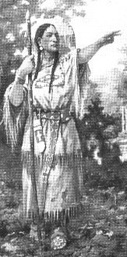
by Jessica Carlile
Sacajawea was born sometime during 1786 in a territory located in todayís Idaho. She lived in her Rocky Mountain homeland the first 12 years of her life, up until she was kidnapped from her Shoshone people by an enemy tribe, the Hidastas. Sacajawea was then sold to a French-Canadian fur trader named Toussaint Charbonneau as a slave, and was soon after claimed as one of his wives. During this time an expedition to explore the Louisiana Territory was being formed by Meriwhether Lewis and William Clark. When the Lewis and Clark expedition passed through the Hidasta-Mandan village, the expedition was forced to camp and build a fort near the Mandan village because of the harsh winter that lay ahead. The fort was called Fort Mandan. Charbonneau and Sacajawea were hired as interpreters to travel with the expedition once the weathered had cleared.
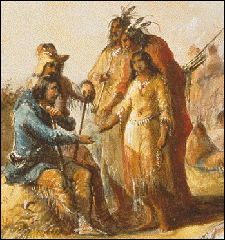
A painting called "The Trapper's Bride"
by Alfred Jacob Miller.
The Shoshone Indian tribe possessed the horses Lewis and Clark needed to cross the Bitterroot Mountains during expedition. With Sacajawea speaking Hidasta and Shoshone, Charbonneau speaking Hidasta and French, and their other interpreter Francois Labiche able to transtate the French to English, the Indian women and her husband added a key element needed for the success of the expeditionís dealings with the Shoshone Indians
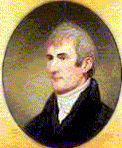
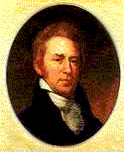
Meriwether Lewis and William Clark
Sacajawea would be the only woman among a party of 33 men. In 1805, during the journey Sacajawea gave birth to a baby boy which they named Jean Baptiste Charbonneau. "Pompy" was a nickname given to her son by Captian Clark, meaning "little dancing boy." The baby rode on the young Indian womanís back as she helped gather roots, and collect edible berries and plants.
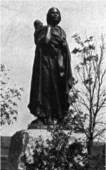
Sacajawea carrying
Pompy on her back.
Sacajawea was became known for her perseverance and resourcefulness. She also gained the captainís respect for her bravery during the wrecking of one of the exploring boats on the river. After the 75 mile trip crossing the Continental Divide the party was found by a group of Shoshones. The Shoshone leader was Sacajaweaís own brother Camcahwait, and after 5 years Sacajawea was finally reunited with her family. Thanks to Sacajawea, Lewis and Clark were able to purchase the horses needed for their westward travel. Sacajawea proved valuable as a valued interpreter and peacemaker in the expeditionís meetings with new tribes, who were ready to defend their land, and during encounters with Shoshone speaking chiefs. She guided the expedition through her familiar homelands and proved to be invaluable to the leaders.
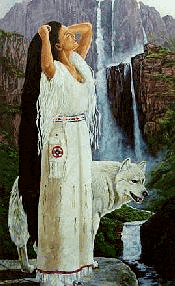
Sacajawea, the Squaw.
After the expedition, Sacajawea returned to her Hidasta-Mandan home with her husband Charbonneau, and their son Baptiste. Six years later she gave birth to her daughter Lisette on December 22, 1812. Although Sacajawea died at age 25, mainly from childbirth complications at fort Minguel in South Dakota, another woman later claimed to be her.
An old Native American woman later claimed to be Sacajawea. She lived on a reservation and seemed to know a considerable amount of information about the Lewis and Clark expedition. Today, this woman is now thought to be one of Charbonneauís other wives.
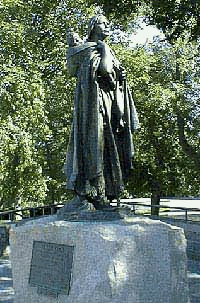
Sacajawea Statue in Bismarck, North Dakota.
Sources:
"Lewis and Clark" @ http://www.pbs.org/weta/the west/, 12-18-00
"Sakajawea" @ http://www.netsrq.com/~dbois/, 12-18-00
Encarta Encyclopedia 2000 (CD-ROM) Microsoft 2000
"Sacajawea" @ http://www.webaccess.net/~coolclas/sacaj.htm - 1-5-01
"Sacajawea: Guide to the West?" @ http://womenshistory.about.com/library/weekly/aa05//99.htm - 1-5-01
Picture Credit:
Picture #1 - "Sacajawea" from: http://www.rootsweb.com/~nwa/sacajawea.html
Picture #2 - "Trapperís bride" from: http://www.pbs.org/weta/thewest/
Picture #3 - "Lewis and Clark" from: http://dir.yahoo.com/Arts/Humanities/History/U_S_History/Lewis_and_Clark_Expedition/
Picture #4 - "Sacajawea & Baby" from: http://womenshistory.about.com/library/weekly/aa05//99.htm
Picture #5 - "The Squaw" from: http.//www.webaccess.net/~coolclas/sacaj.htm
Picture #6 - "Sacajawea Statue" from: http.//www.netsrq.com/~dbois/